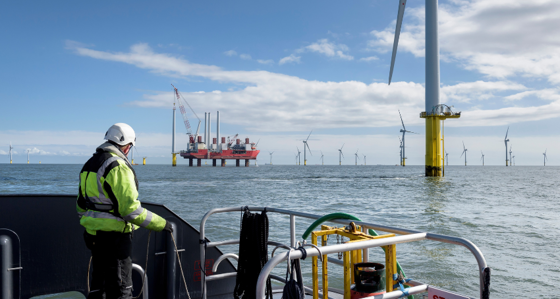
Future operating models for energy retailers: A clear path to success
7 min read 19 November 2024
Energy retailers are at a critical juncture. As the energy landscape shifts, companies must go beyond simply selling energy and embrace a future where non-commodity products like electric vehicle (EV) chargers and heat pumps play a central role. Notwithstanding the decarbonisation obligation, from a commercial standpoint, it is becoming increasingly necessary to diversify product portfolios beyond commodity-only offerings. This transformation requires new capabilities, a rethinking of current sales and service models, and the agility to respond to evolving market and customer needs. Here’s a focused guide on how energy retailers can successfully adapt their commercial, sales, and servicing operations.
Key commercial challenges and solutions
The transition to a multi-product model brings several commercial challenges that must be addressed strategically.
Under a model where low carbon technologies form part of the strategic direction and future product mix, energy retailers need to build specialised capabilities to handle product design and bundling. This will require forming specialist teams that stay informed on emerging products and ensure that offerings align with customer demands. In addition, supply chain complexities of delivering bundled solutions necessitates a rethink of the end-to-end customer lifecycle and subsequent journeys within to optimise value not just to customers but to the energy retailer and shareholders. The following four areas have emerged as critical components in delivering multi-product non-commodity solutions:
- Customer lifetime value is crucial when developing new products. It’s essential to assess which product combinations deliver the greatest value and lead to long-term customer loyalty.
- Partnerships will also play a key role in expanding product portfolios. Retailers should consider forming or growing partnerships with suppliers, such as heat pump and solar manufacturers, to secure better pricing and improve product availability.
- Whether outsourced or managed in-house, training field teams to assess, install, and maintain products is vital for success. Retailers must decide whether field agents should specialise in certain products or be generalists with knowledge across the full product range. Additionally, agents should be able to engage customers in discussions about potential future purchases, helping them with details to the products or regulatory requirements which need to be considered for e.g. installing a heat pump or battery storage, even if they aren’t immediately buying.
- Product lifecycle management is another critical factor. Energy retailers need to carefully manage products through their lifecycle stages, from launch to market maturity, and be prepared to innovate when needed. Regular benchmarking against competitors will ensure they stay ahead of market trends.
Recommendations for commercial adaptation:
- Invest in specialist teams to stay ahead of emerging product trends, develop innovative offerings, and continuously monitor and enhance products throughout their lifecycle, ensuring competitiveness through benchmarking against rivals.
- Focus on bundling strategies that enhance customer lifetime value, driving loyalty and satisfaction.
- Leverage partnerships with suppliers to expand product portfolios and secure better prices.
- Train field teams to handle the full product lifecycle, from assessment to installation and beyond.
- Train the front and back-office teams for better service and faster handling of requests in the back office so that the customer experience is satisfactory
Aligning sales and service for greater impact
A multi-product approach offers clear benefits, particularly if sales and service are integration can be realised.
By combining these functions, retailers can streamline operations and provide a more seamless customer experience. This integration enhances customer engagement by offering a broader range of solutions to meet individual needs, leading to greater opportunities for upselling and cross-selling.
However, this model comes with risks. There is a danger that agents might prioritise sales over service, leading to a potential decline in customer satisfaction. Retailers must ensure that quality service remains a priority even as they focus on driving revenue. Moreover, training agents to manage both sales and service requires substantial investment in developing their knowledge and skills.
Retailers should also consider the maturity of their data and technology. Effective tools that provide next-best-action insights can help balance sales and service functions, enabling agents to offer the right recommendations at the right time.
Recommendations for Sales and Service Integration:
- Combine sales and service functions to provide a more unified and customer-friendly experience, with consideration to the complexity of product offerings and alignment of sales and service teams to customer value streams.
- Invest in agent training to ensure they can handle both sales and service without compromising on quality.
- Leverage data and technology to offer personalised, next-best-action recommendations that enhance customer experience. Likely to be realised when low-value service-related tasks are eliminated through AI to enable agents to focus on high-value interactions.
Balancing multiskilling and specialisation in customer service
Energy retailers face a choice between multiskilled, universal agents and product specialists. Universal agents offer versatility, as they can handle a wide variety of queries and resolve issues at the first point of contact. This approach reduces operational silos, cuts hand-offs, and drives excellent customer service while keeping costs down.
On the other hand, product specialists provide deep expertise and are well-suited to handle more complex customer issues. Their knowledge allows for tailored solutions that meet specific customer needs, which can improve satisfaction and create opportunities for upselling.
Retailers must strike the right balance between these two approaches. The decision will depend on the complexity of the products, the diversity of customer needs, level of system intelligence and embedded training
Recommendations for optimising customer service:
- Assess your service needs to determine if multiskilled agents or product specialists offer the best value for your customer base.
- Tailor your service model to match the complexity of your product range and the expertise needed to deliver exceptional service.
- Use universal agents where versatility and first-contact resolution are essential and deploy specialists for handling complex queries that require in-depth product knowledge.
Segmenting teams for tailored service delivery
Segmenting service teams based on customer value streams or product types allows energy retailers to offer more personalised service. This approach enables agents to develop specialised knowledge, ensuring that each customer interaction is tailored to their specific needs. As a result, segmenting teams can improve customer satisfaction, build stronger relationships, and drive revenue growth.
However, segmenting teams can also increase operational complexity. Retailers must manage different teams with varying focuses, which could lead to more intricate team structures. This may affect flexibility, with agents potentially limited to handling queries only within their segment. Investing in intelligent CRM systems that enable skills-based routing can mitigate these issues and ensure efficient service.
Recommendations for team segmentation:
- Segment teams based on customer value streams or product types to deliver more tailored service and increase customer satisfaction.
- Invest in systems that allow for skills-based routing to ensure customers are matched with the right agents.
- Monitor team performance to ensure that segmenting does not reduce flexibility or slow response times.
Conclusion: A clear path to success
Energy retailers must evolve to remain competitive in a multi-product landscape. By investing in new capabilities, integrating sales and service, and balancing multiskilling with specialisation, they can meet the needs of their customers and drive sustainable growth. Segmenting teams and leveraging partnerships will further enhance their ability to provide personalised service and innovative solutions.
To navigate the future successfully, energy retailers should focus on:
- Building specialised teams to stay ahead in the non-commodity product market.
- Integrating sales and service for a more streamlined customer experience.
- Balancing generalist and specialist models to match customer needs and product complexity.
- Segmenting service teams to deliver targeted, efficient support for diverse customer segments.
With the right operating model, energy retailers can confidently embrace the future and position themselves for long-term success in a rapidly evolving market.
If you are interested in discussing the future of sales and service and the impact this may have on your strategy and operating model, please get in touch with us.
Our Experts

Related Insights

Trump trade tariffs: Impact on the UK EV uptake
The global automative industry is at a critical juncture, shaped by intersecting forces of electrification, geopolitical trade tensions, and national decarbonisation policy.
Read more
Create an “offshore energy mission control”, new report to argue
The UK needs to create an offshore energy “mission control” that has the power to cut through and connect different stakeholders, from government bodies, to oil and gas operators, renewables developers and financial institutions, argues a new report commissioned by Offshore Energies UK (OEUK) and created by management consultancy Baringa.
Read more
Driving economic growth by securing a cleaner and resilient future for the North Sea
Our report, published in conjunction with Offshore Energies UK (OEUK), outlines how the North Sea can continue to play a pivotal role in the energy system as the world shifts to net zero, while positioning the UK as a resilient, innovative and competitive player in the global energy landscape.
Read more
From early adopters to early majority: Driving the next phase of EV growth
As EVs are moving beyond the early adopter phase, what are the principles needed for mass market adoption and progressing towards net zero targets?
Read moreIs digital and AI delivering what your business needs?
Digital and AI can solve your toughest challenges and elevate your business performance. But success isn’t always straightforward. Where can you unlock opportunity? And what does it take to set the foundation for lasting success?